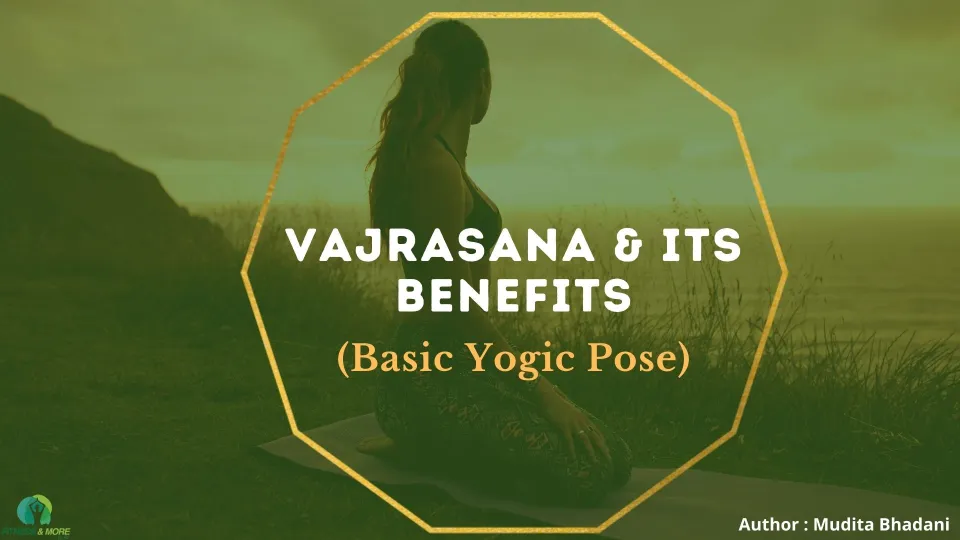Vajrasana, like Sukhasana, is one of the most common sitting postures and can be performed by people of all ages. It is a meditative posture and people for whom Padmasana and Sidhasana are advanced poses, can sit in this posture for meditation. The posture is also being used by Muslims and Zen Buddhist community for their prayers.
This is an asana which can be performed even after eating food and it helps to alleviate all types of digestive problems. In today’s life, wherein most people are suffering from digestive issues, this is an easy to go asana for people of all ages.
Why Vajrasana?
Vajrasana is a very simple sitting posture and a novice can start its practice with this asana as it is comparatively easy to perform than other asanas and helps to strengthen the knee, ankles, hips, spine and digestive system. Further, it also helps to relax the body muscles.
What is Vajrasana?
The word Vajrasana consists of two Sanskrit words, Vajra and Asana. Vajra means Diamond-like or Thunderbolt and Asana mean “posture”. According to Hindu Mythology, Vajra is said to be the most powerful weapon of God “Indra” and it is made of bones. Like ways, regular practise of this posture, makes a Yogi very robust and steady, both physically and mentally. Therefore, this posture is called Vajrasana.
Further, there is another school of thought that this posture is called Vajrasana as helps to activate the Vajra Nadi in our body. Vajra Nadi is located within the spine. It begins from the Muladhara chakra (base chakra) and goes to mind. It regulates the energy in the body.
This posture is also called as Diamond pose, Adamant Pose, Thunderbolt pose, Pelvic pose and Keeling pose
Vajrasana as per various scriptures
- Hatha Yoga Pradipika
Chapter 1, Verse 39
“एतत्सिद्धासनं पराहुरन्ये वज्रासनं ववद ुः |
म क्तासनं वदन्त्येके पराहुर् ुप्तासनं परे || ३९ ||”
Meaning: Some call this Siddhasana. Some call it Vajrasana, Others Muktasana. But it is also Guptasana.
Hatha Yoga Pradipika after explaining Siddhasana in Verse 37 and 38 of Chapter 1, explains that Vajrasana is also a synonym posture of Siddhasana. However, in modern yoga, the postures mentioned above are different.
- Gheranda Samhita
Chapter 2. Verse 12
Meaning: Make the thighs tight like adamant and place the legs by two sides of the anus. This is called the Vajrasana. It gives psychic powers to the Yogi. - Yoga Kundalini Upanishad
Verse 1.6
Meaning: One should place the left heel under the knot of the navel and the other heel over it, with his neck, head and body in a line. This is known as the Vajrasana posture
Further, this posture is recommended for the practice of Yoga – Kundalini.
Benefits of Vajrasana
This posture has a lot of physical and mental benefits. Some of the major benefits are as follows:
Physical benefits
- One of the best asanas for beginners for meditation, who cannot perform advanced asanas.
- It activates Vajra Nadi, which regulates the sexual energy of the body.
- It can be performed after a meal. Further, it strengthens the digestion system of the body and helps to reduce digestive issues such as constipation, acidity, gastric problems etc. It also aids in digestion.
- It improves blood circulation in the pelvic region and strengthens the pelvic muscles.
- It also helps in weight loss and reduces fat on the thighs and hips.
- It strengthens the back muscles and helps in relieving the pains in the lower back.
- It strengthens the thighs, knees and ankles and increases the flexibility in said parts.
- It improves the posture of the body.
- It relaxes the entire body and helps in removing fatigue.
- For women, it helps to regulate their periods and also reduces menstrual cramps.
Mental Benefits
- It acts as a foundation for starting meditative practices for beginners.
- Regular practice with a focus on the nose or third eye helps to increase our focus and concentration power.
- It relaxes our mind and body and reduces the stress level.
- It helps to increase the awareness of the body.
- It also reduces insomnia.
Preparatory Poses
It is a simple asana, however, people who find it difficult to sit in Vajrasana can start with a butterfly pose and Dandasana. It will reduce stiffness in the lower body and help to sit in Vajrasana. Sun salutations can also be done to reduce stiffness in the lower body.
Who should not do Vajrasana?
- People who are suffering from any knee, or ankle injuries should not perform this pose
- If you are having slip disc, then you should try avoiding doing the pose
- Try to keep your spine straight and elongated while performing this asana
- Do not sit in this posture, if you are feeling any discomfort in this pose
How long can it be done?
Starting practice can be done for 2-3 minutes which can be extended to 10-15 minutes as per the stamina of the body. Further, when the body gets accustomed to this pose one can sit in this posture for longer periods.
Steps to perform Vajrasana
- Sit on the floor in the Dandasana position with your legs stretched outwards.
- Bend your both legs and place the feet under your hips.
- The toes should be touching the hips and the thumbs should be touching each other.
- The soles would be facing upward and the heels would be outwards.
- The spine should be kept straight and erect. Chin should be parallel to the floor and look in front.
- Your body should be in a straight line. The neck should be elongated.
- Put both the palms on the thighs
- Inhale and exhale slowly in the same position to relax the body. Keep your eyes closed and try to focus on your nose or in the middle of your eyebrows.
How to start for beginners?
- The beginners, who are not able to sit comfortably in this position, may keep a blanket or bolster under their ankles to support.
- In case you are not able to balance your legs, the support of a wall can be taken.
- Beginners can also start with placing one ankle over another ankle. This will help to reduce the stretch on the ankles
- You can also try placing a yoga block between your feet horizontally. This can take pressure off the ankles and knees.
- In case you are not able to concentrate during this position or feel sleepy, try focusing on the inhalation and exhalation and their impact on the chest, stomach and spine. For starting you can try with your eyes open and concentrating on a single point.
Some asanas to be performed in Vajrasana
- Neck movements: A person can move their neck up and down or on the right side and left side while resting in this position. It can also side stretch the neck. It promotes neck flexibility and also helps to release tension in the back and shoulders.
- Hand and Shoulder Rolls– Extend hands on both sides sidewise and then rotate hands in a circular motion clockwise and anti-clockwise while sitting. Further, shoulder rotations can be done while sitting.
- Forward Bend: Bend forward by extending both arms on the floor and try to touch your nose towards the floor. Try to keep your hips on the feet.
- Revolved pose: Place your right hand on your left knee and put your left hand on the floor and try to slide your hand backwards and twist your body. Try to look back. It strengthens shoulder and back muscles.
- Supta Vajrasana: Sit in Vajrasana position. Place elbows on the floor and slowly lean the body back and try to touch the crown to the floor.
- Camel Pose
These poses stretch and strengthen the shoulder, hand, neck and back muscles. It also aids in relieving pains in the body.
Vajrasana and Meditation
Padmasana and Siddhasana are said to be the best poses for meditation, but these are advanced poses and cannot be performed by each and every person. However, it is comparatively easy to sit in Vajrasana and do Meditation. Further, the back remains straight in this posture as compared to Sukhasana.
A beginner can start the practice by sitting comfortably in Vajrasana and closing the eyes and concentrating on the inhale and exhale of breath. He should remain aware during his practice and try to focus on the flow of breathing and its impact on the chest, stomach and spine. For starting, it can do for 2-3 minutes and can be gradually increased to 15 minutes.
My Experience with Vajrasana
Vajrasana is a more challenging asana that Sukhasana for a beginner. In the starting, it was very difficult to sit in Vajrasana for more than 1 minute as it used to impact my thighs and ankles. My thighs and ankles used to pain while sitting in this posture as my lower potion was chubby.
Therefore, I used to keep one ankle over the other to reduce stress on the ankles. Sometimes I tried to sit on a blanket or floor cushion to reduce the stress.
However, Suryanamaskar helped in reducing stiffness in the lower body. With time, I am able to sit in posture continuously from 1 minute in the beginning to 15- 20 minutes.
Further, it also, helped me to reduce the digestive problems which I was facing. It also helped to reduce menstrual cramps.
On the mental level, it helped to increase focus and concentration. It also helped me to be aware and remain more focused during my practice.
Till date, I love to sit in Vajrasana after having food, as it helps in digestion and reduces gastric problems.
Caution
While Vajrasana is a very easy pose and provides a lot of benefits, if you have any knee, ankles or back injury or pains, it is advisable to avoid it or to do it after consulting with a yoga trainer. Further, in case you are feeling pains while or after doing this pose, do consult your Yoga trainer before continuing the practice.
Do remember that everybody is different and the impact of asanas on everybody is different.
HAPPY DOING YOGA!!


Thank you for giving motivation for 🧘♀️ Yoga
Welcome, We’re here for you 😊